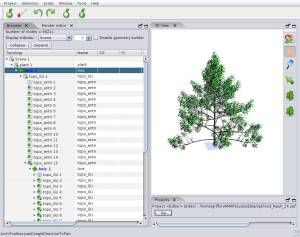Table of Contents
How can I load MTG, OPF or OPS files in Xplo ?
Launch Xplo
After having run the installer, launch Xplo with one of these options:
- In your file manager, go to the installation directory and double click on the xplo script: xplo.bat for Windows, xplo.sh for Linux and Mac.
Note: For Linux and Mac, it may be needed to change the permission of the script to enable the 'executable' property.
* Alternatively, you may type the commands in the terminal
If the graphical user interface does not follow this layout, choose Window > Edition layout.
Import a file
MTG and OPF files are used to encode tree architecture data. To load those files you need to :
- Project > Import
- Select the file format you want to load > Ok
- Choose files to be imported in Xplo > Open
For instance, try to load AMAPstudio/data/opf/mod_Rauh_14.opf :

Browse the plant architecture
In the browser, you can inspect your data in a tree table. This view is capable of both expanding and contracting the architecture, as well as showing multiple columns of attributes. Each icon represents a topological link with the previous element :
![]() = This element has component(s)
= This element has component(s)
![]() = This element has a predecessor(s)
= This element has a predecessor(s)
![]() = This element has components and branch(es)
= This element has components and branch(es)
![]() = This element has component(s) and a predecessor(s)
= This element has component(s) and a predecessor(s)
![]() = This element has component(s),branch(es) and predecessor(s)
= This element has component(s),branch(es) and predecessor(s)
Zoom, rotate, pan the 3D view
Use the 3D View navigation toolbar to navigate in the scene
- Rotate
- Pan
- Zoom
- Select
- Center view on current selection
- Reset view
Edit the rendering of the plant
Each plant element type is displayed in a layer. A layer can be hidden or displayed in the 3D view, by checking or not the layer in the list.
To configure the rendering of a layer, you need to select the layer in the list and edit the configuration panel (below the layer list).
- Geometry
To display specific shapes for an element type, select “Use a mesh” then click on the button “…”. Select a smb or obj file (shape should be normalized).
To display cylinders (usefull for the branches), select Tube. Tubes can be computed only on axis that are composed of sub-elements. The spinner can be used to smooth the shape.
- Material
To change the color of an element type, select Default color and choose a color by clicking on the button.
To display a gradient color according attribute values, select Gradient Color, then select an attribute name.


